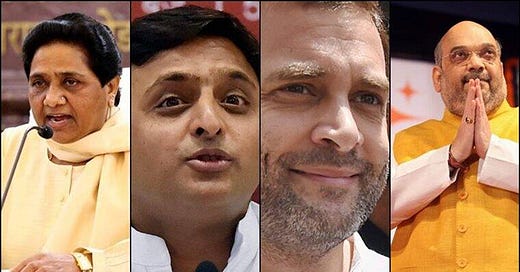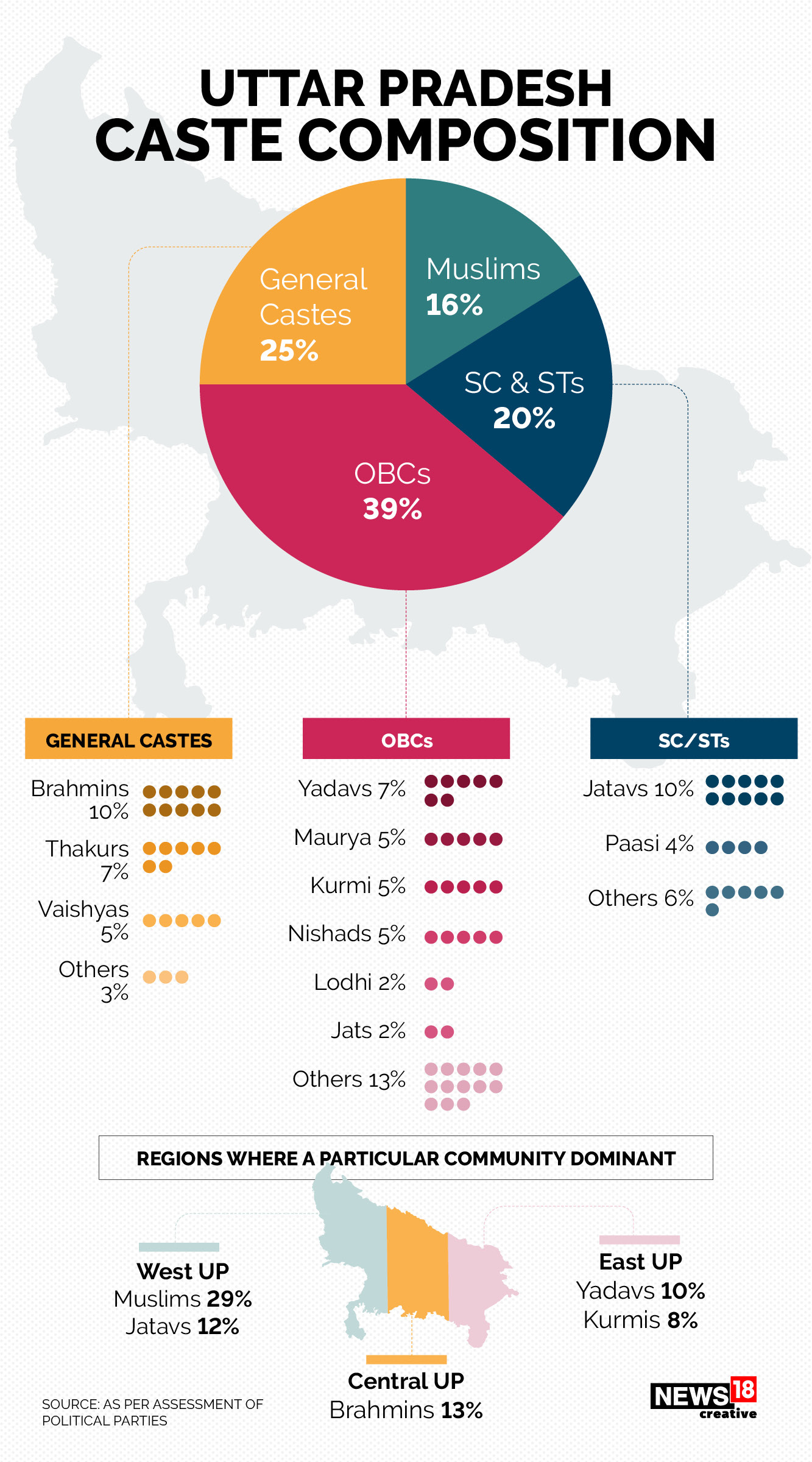Caste Politics in Uttar Pradesh
It is often said that when one casts their vote in Uttar Pradesh (UP), one votes their caste. With the 2024 national election around the corner and having already suffered a humiliating defeat from the hands (and a broken foot) of Mamata Banerjee, Bharatiya Janata Party (BJP) cannot afford to lose any more states from its portfolio. This election season will also be a test for the Aam Aadmi Party (AAP) and the Trinamool Congress (TMC) who have threatened to challenge the constantly declining Indian National Congress (Congress) at the national level.
The following is the caste demographics of Uttar Pradesh (source)
Political Analyst Ashutosh Varshney uses his 20-20-20-40 formula to explain the winning formula for UP. Muslims, upper castes, and Dalits account for 20% each and Other Backward Classes constitute 40% of the votes and “if [a party gets] any two of the 20s or if [it] could get even half of any of the 20s and [it] controlled the 40, [it] could rule the state,” says journalist Shekhar Gupta. In 2007, the Bahujan Samaj Party (BSP) came into power with the Muslim-Dalit vote bank, whereas the Samajwadi Party (SP) was elected in 2012 with the majority of Muslim-Yadav votes.
Upper Castes
The upper castes clearly dominate UP politics and have a big say in what colour the state turns. There have been six Brahmin Chief Ministers. Currently, 16 out of the 24 cabinet ministers belong to the upper castes. Thus, no political party is leaving any stone unturned to woo the communities into their fold. Traditionally, upper castes, especially Brahmins, have always voted for Congress. However, the “Mandal, Mandir and Market” politics made the Brahmins change their allegiance to the “saffron party.” Yet, Brahmins have been upset under the governance of Thakur chief minister (CM) Yogi Adityanath. They feel that they have been marginalised and that the CM favours Thakurs to the Brahmins. The death of Brahmin gangster Vikas Dubey and his eight associates has also not gone well with the community. Doing damage control, BJP set up a committee to work on outreach programs to bring the community back into their fold in the 2022 elections. The committee is working with full force and has already reached out to 80 Brahmin societies and organisations to spread awareness. BJP also inducted brahmin leader and Congress defector Jitin Prasada in 2021 and gave him a cabinet portfolio to please the brahmins. BSP and SP have kicked off their own Brahmin “sammelans” and have promised to build a statue of Lord Parshuram to woo the Brahmins.
Muslims
Muslims have traditionally voted for Congress, SP, and BSP. In 2012, Akhilesh Yadav won half of the Muslim dominated seats and went on to become the CM. In 2022, SP feels confident that it has the support of the Muslims and hopes to do well in Muslim-majority seats. SP leaders believe that Muslims have no other choice but to support them “if they want to oust the BJP from power in Uttar Pradesh.” Having tasted success in Bihar, All India Majlis-e-Ittehadul Muslimeen (AIMIM) has put up candidates in 100 seats, planning to dent the Muslim vote and make some in-roads in the state.
OBCs
OBCs, constituting 40% of the total vote, came into the political limelight after the Mandal committee in the 90s. It enabled them to earn political power and led to the rise of OBC leaders like Lalu Yadav in Bihar and Mulayam Singh Yadav in UP. In 2017, Yadavs voted for SP while non-Yadav OBCs favoured the BJP, led by the “tallest OBC leader in India” Narendra Modi. Non-Yadav OBCs and non Jatav Dalits were frustrated that SP and BSP favoured Yadavs and Dalits respectively. Thus, BJP appeared as an alternative to them. BJP’s ally Apna Dal(s) is headed by Kurmi leader Anupriya Patel. Om Prakash Rajbhar and his party Suheldev Bhartiya Samaj Party (SBSP) is the mascot for the Rajbhar community and fought elections with BJP in 2017. As many as 101 BJP candidates from OBC categories reached the UP legislature in 2017. However, 10 OBC ministers, including cabinet ministers, have recently quit the party citing that the government is oppressing the Dalits and the farmers. A senior BJP OBC leader, who is still in the BJP, says: “Yogi Adityanath has been unjust towards the OBCs and has only backed the upper castes. I only wish my fellow OBCs had rebelled a couple of years ago; then, we might have succeeded in replacing Yogi Adityanath as Chief Minister.” Most of the ministers have joined Akhilesh’s SP which is trying to snatch away the non-Yadav OBC vote bank and shed its title of being a ‘Muslim-Yadav’ party. It has formed alliances with other small parties. Jayant Chaudhury’s Rashtriya Lok Dal (RLD), which supported the farmers’ movement, and SBSP have already formed a pre-poll alliance with the SP.
Dalits
Dalits had voted for the grand old party for a long time until the rise of Kanshi Ram. In 1984, Dalit leader Kanshi Ram formed the BSP with the slogan of “Vote hamara, raj tumhara — nahi chalega, nahi chalega.” BSP has been voted to power four times since 1995 with Kanshi Ram’s protégé Mayawati serving as the CM in all four stints. Over time, non Jatavs felt that Jatavs were being preferred by the party and switched their allegiance to BJP in 2014, similar to non-Yadav OBCs. BJP received 45% of the total non-Jatav Dalit vote which rose to 48.9% in 2019. However, the horrific Hatras rape case where a Dalit woman was raped and killed by upper caste men has put the BJP government under scrutiny by the opposition and the public and has angered the Dalits in the region.
All parties are fighting the UP elections with all their political and financial might. They are trying to set their voting equation correct and leaving no stone unturned. However, only time will tell whose math prevails.
Please write to keshavpransukhka@gmail.com for feedback and suggestions








